Reserve museum «Tanbaly»
Petroglyphs
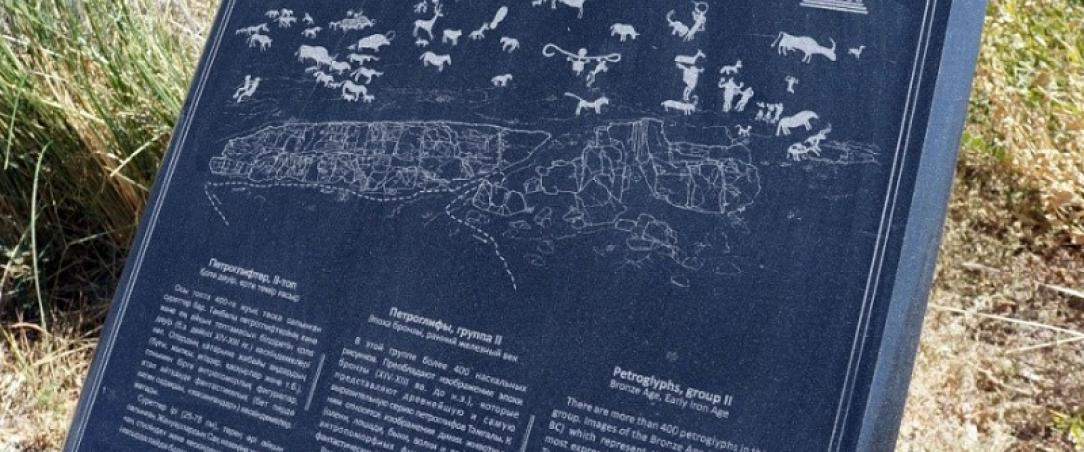
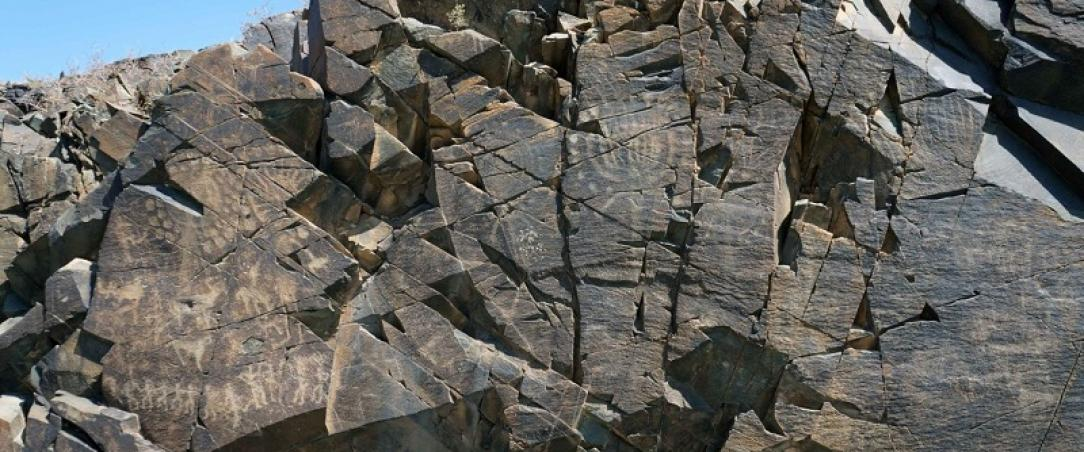
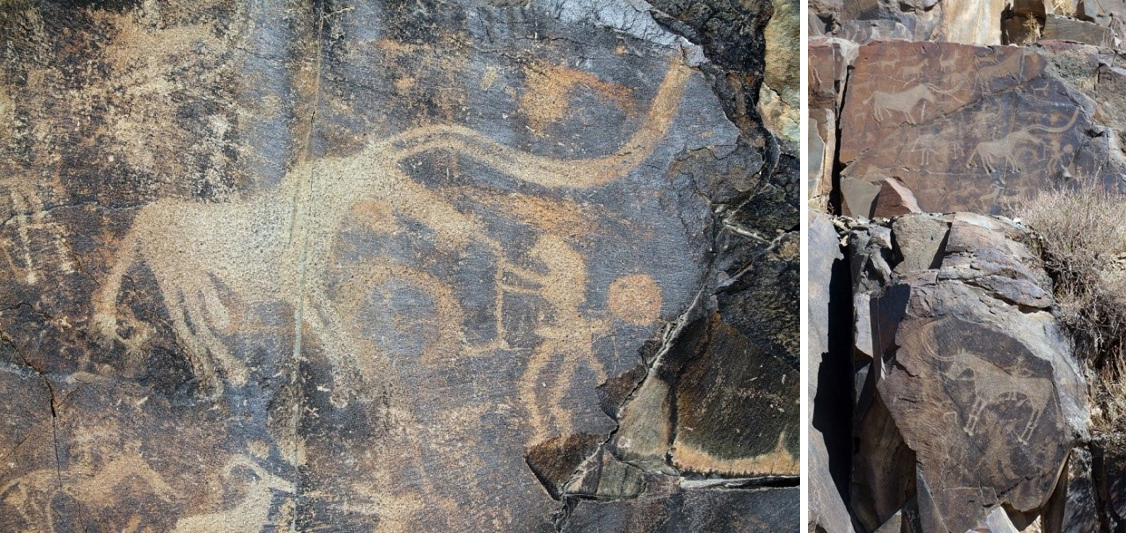
The petroglyphs of Tanbaly were knocked out in the picket technique with stone or metal tools. All of them were divided into 48 separate complexes during the documentation. A real masterpiece of rock art is considered to be a plane of considerable size with impressive 6 images of "sun-headed" deities (?), embossed on top of small images of dancing and praying people. The large size of the early petroglyphs, their unique pictorial content and iconography place them on a par with the most valuable rock art images of Central Asia.

Petroglyphs of Tanbaly. The main part of the tour goes through the monuments of rock art, united in groups of petroglyphs. Among the thousands of petroglyphs of Tanbaly, a homogeneous series of ancient images created at the turn of the XIV-XIII centuries BC during the development of South-Eastern Kazakhstan (Semirechye) by pastoral tribes of the Andronovo cultural and historical community stands out. The petroglyphs of the Bronze Age of Tanbaly testify to the highest level of development of this type of fine art during its heyday and widespread distribution in Central Asia. The specificity of these drawings, according to the fair conclusion of A.E. Rogozhinsky (large sizes from 25-75cm to 1.0 m, technique, style, iconography, repertoire and the presence of narrative construction) allows them to be singled out especially as a type of Tanbaly petroglyphs.
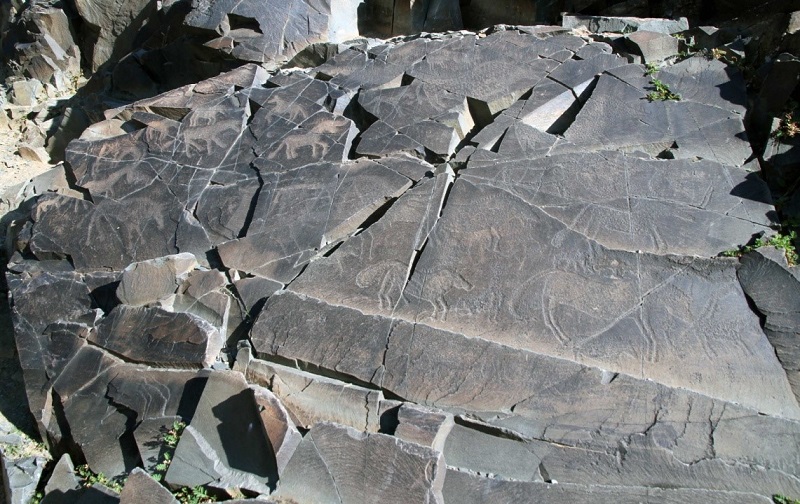
Petroglyphs, group II (N 43º4813,28; E 075º3214,14). The Bronze Age, the Early Iron Age. There are more than 400 rock paintings here. Images of the Bronze Age (XIV–XIII centuries BC) predominate, which represent the oldest and most expressive series of petroglyphs of Tanbaly. These include images of wild animals (deer, horses, bulls, wolves, etc.), as well as anthropomorphic figures, including fantastic ones (an archer in a mask, "mummers"). The drawings are large (25-75 cm), deeply and carefully embossed. Individual images of animals in the Saka "animal style" were created in the I millennium BC.
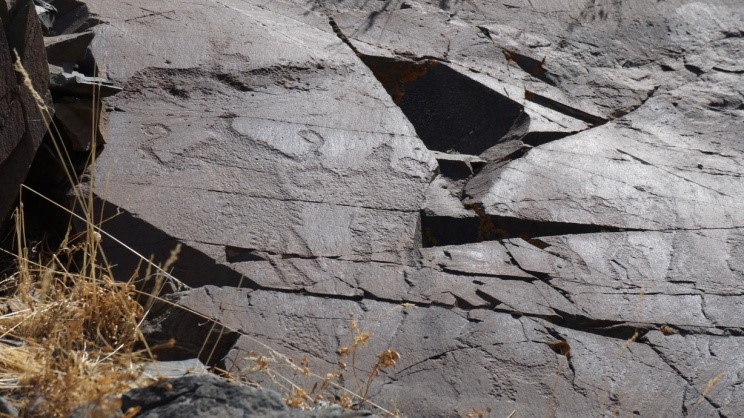
Petroglyphs, group III (N 43º4813,16; E 075º3214,42). The Bronze Age, the Early Iron Age, the Middle Ages. There are more than 400 rock paintings here. Images of the Bronze Age (XIV–XIII centuries BC) predominate, often renovated in later periods. These include scenes of hunting wild animals (kulans, mountain goats), bull sacrifice, etc. The masterpieces of rock art are the figures of a "sun-headed deity" on a bull and a "pregnant" cow. The scene of human sacrifice belongs to the Late Bronze Age (XIV–XIII centuries BC). By the Saka period (ser. V century BC) include animal figures in the "animal style" and a scene of a battle dance of warriors with axes.
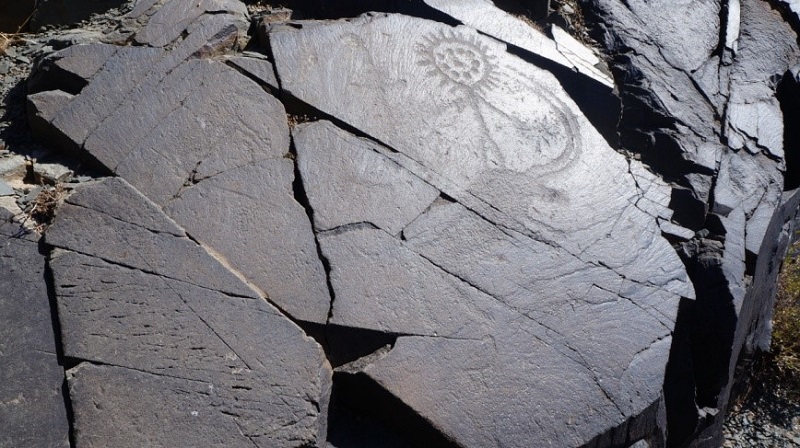
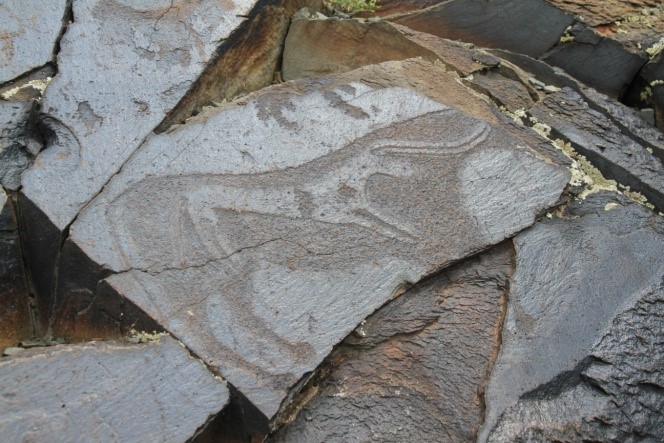
Petroglyphs, group IV (N 43º4813,18; E 075º3205,04). Bronze Age, Early Iron Age, Middle Ages, Modern Times. The rock with petroglyphs forms the compositional and semantic center of the sanctuary of Tanbaly – the "open-air temple". There are more than 700 rock paintings here. The Bronze Age (XIV–XIII centuries BC) includes a unique composition with images of 6 "sun-headed deities", supplemented by a number of other petroglyphs in the early Iron Age (VI-V centuries BC) and the Middle Ages. The Turkic runic inscription belongs to the IX–X centuries, to the XVII – ser. XVIII century. Oirat prayer inscriptions "Om mani pad me hum", by the XIX - beginning. XX century. tamga of the Kazakh tribe dulat Senior zhuz.
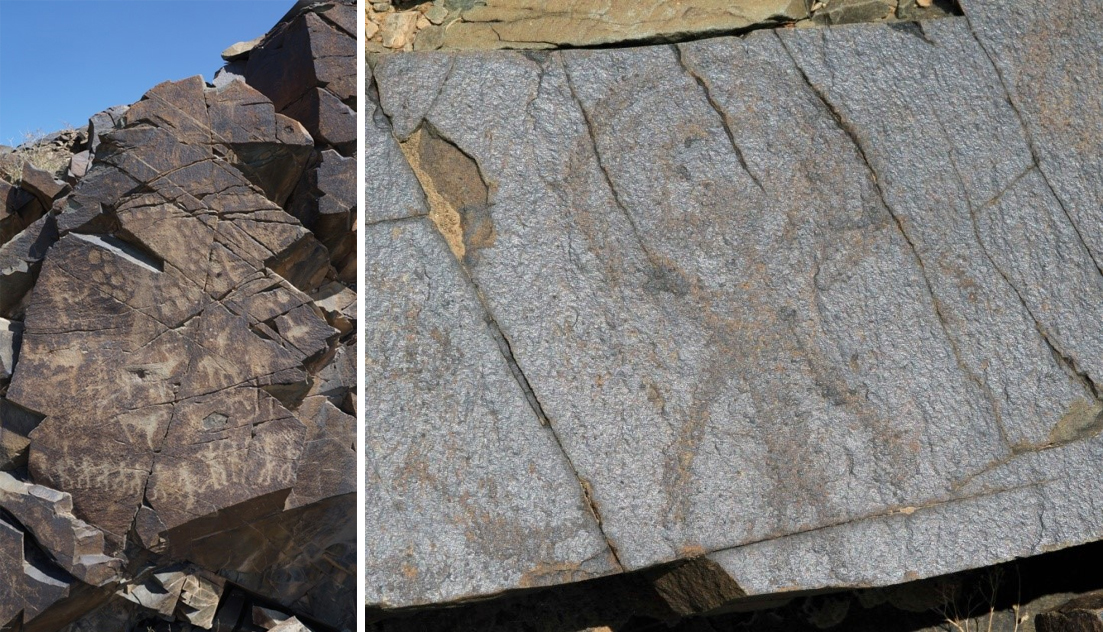
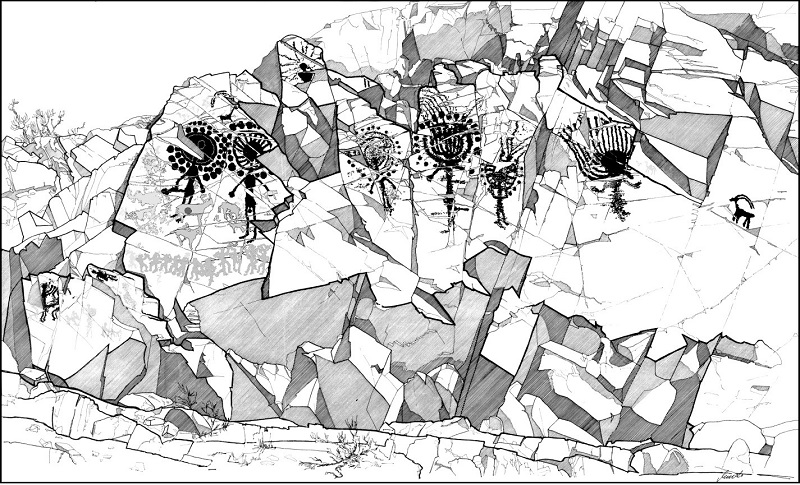
In the central part of the group, on the upper terrace of the canyon, there is a so-called "Pantheon" of the Bronze Age and a Picture of the Universe. Group IV, pl. 118. The vertical rock with petroglyphs is the highest in the Tanbaly Canyon and forms the semantic center of the "open-air temple". The surface with the drawings is facing south, and all the characters depicted on it are oriented according to the countries of the world, respectively. Petroglyphs belong to different eras; there are 52 drawings in total.
The Bronze Age. Frieze of "sun-headed" characters: six large anthropomorphic figures, differing in height (from 52 to 74 cm), the shape of "halos", the position of the hands (raised up or lowered), turning left (west), right (east) or frontally (south /north). Above them is the figure (torso and head) of the seventh (?) a "sun-headed" character. From the bottom left – two figures of people facing each other in a prayer pose ("adorants"); above - a fragment of the scene of the "sacred marriage".
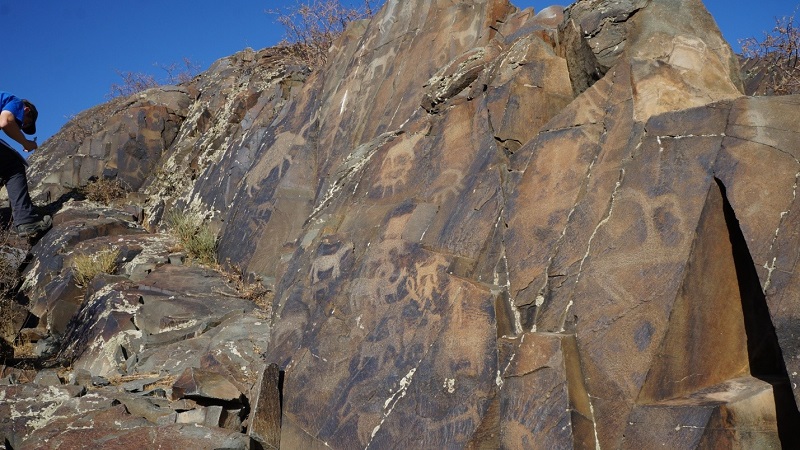
The panel contains all the main types of "sun-headed" characters of Tanbaly, depicting a gathering of "all the gods" (pantheon) and ritual worship of them. The composition has no analogues.
Early Iron Age. Eleven anthropomorphic figures: ten dancing warriors with axes, in the center - the figure of a woman in labor. Above are depicted a horseman on a horse, a wild boar and other animals in the Saka "animal" style. Some figures overlap the images of the "sunheads", but in general harmoniously complement the composition of the Bronze Age and convey the Picture of the Universe in the representations of ancient nomads. The remaining petroglyphs were created in the Middle Ages and later.
Petroglyphs, group V (N 43º4813,28; E 075º3214,14). The Bronze Age, the Early Iron Age, the Middle Ages. There are more than 1000 rock paintings here. The Bronze Age (XIV–XIII centuries BC) includes several large compositions with images of animals (bulls with lines on the body, horses, wild boar, etc.), war chariots and a camel-drawn cargo cart, as well as anthropomorphic figures, including 11 images of "sun-headed deities". Compositions with images of deer in the style of "deer" stones of Mongolia and in the Saka "animal style" date back to the first half of the I millennium BC. In the Middle Ages, images of an anthropomorphic deity (?) sitting in a "feasting pose" with rays around his head, horse riders, deer, as well as tamgas of Turkic tribes were created.
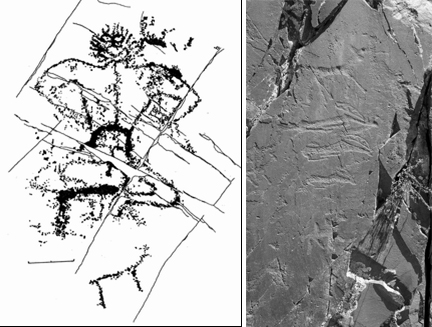
Fig. Drawing of a seated anthropomorphic deity
on the V group (A.E. Rogozhinsky).
Early Iron Age. Eleven anthropomorphic figures: ten dancing warriors with axes, in the center - the figure of a woman in labor. Above are depicted a horseman on a horse, a wild boar and other animals in the Saka "animal" style. Some figures overlap the images of the "sunheads", but in general harmoniously complement the composition of the Bronze Age and convey the Picture of the Universe in the representations of ancient nomads. The remaining petroglyphs were created in the Middle Ages and later.
To date, another new route along the monument has been developed and equipped.

Petroglyphs, group VI (N 43º4735,15; E 075º3211,94)
The hill with petroglyphs is located at a distance of just over 1 km from the central zone of the tract, to the south it consists of more than 150 planes containing rock art from the Bronze Age to the Middle Ages and Modern Times. The cluster of petroglyphs, compactly on one hill, has a number of petroglyphs of the Turkic time, including unique ones and emphasizing the originality of rock art of this period. It is at this location that the priorities of rock art activity as a traditional channel of communication of nomads are monitored: the tamga sign and the short runic text become integral attributes of the pictorial series, reflecting the social and legal status of their creators, owners of the territory; the meetings of tribal tamgas fix the hierarchy of nomadic clans, their political integration.
Despite this relative diversity of routes, not the entire territory of the reserve-museum and not the entire range of monuments of the archaeological complex are covered by excursion routes, many of which will be thematic, i.e. for specialists and students, in particular, these are the archaeological monuments of the complex. The localization of groups of monuments is due to the terrain. The relief of Tanbaly is represented by a small-mound on the border with the foothill valley. Absolute heights are 920-980 m . above sea level. A special advantage of the Tanbaly landscape, emphasized by the research carried out by scientists, confirmed by the World Heritage Committee, is its cultural component, unique petroglyphs reflecting the basics of understanding the universe of the population of this territory in the Middle Bronze Age, carved on the most suitable large planes, in the full sense of masterpieces, of course, are a monument of world cultural heritage. It is obvious that this particular area at the junction of low mountains, at the exit of a small river from the tract to a vast valley, was most suitable for reflecting the images of the universe on the rocks.
Despite the seemingly typical landscape of Tanbaly, for the vast Chu-Ili region, it was here that the ancient population of the region organized the largest sanctuary of the Middle Bronze Age, which included this group. We can guess why the choice fell on Tanbaly, but it is clear that the factor of naturalness of the landscape in the organization of the sanctuary played a primary role and could only be "ennobled" by certain canonized images that "cultivated" the natural landscape. The originality of Tanbaly and its landscape can be traced in comparison with other similar monuments of the region. In the era of its functioning, any economic activity: the construction of dwellings, burial grounds, etc., were considered unacceptable and were taken out for its relatively significant size. Active ritual activity continued in subsequent periods of history. On the territory of the reserve-museum, as well as adjacent valleys, settlements and burial grounds of all major periods are marked, starting from the Middle - Late Bronze Age, up to the Middle Ages.
Currently, mainly the cultural landscape is being "exploited" on Tanbaly, but this exploitation is as careful as possible. The general principles of organizing tourist routes on landscape monuments were formulated by architects Imanbekova K.I., Yatsenko E.L., a clear understanding of which was achieved when organizing the main route along the central gorge: "openness and accessibility of the monument ..., the use of the monument without prejudice to it, the balance of management methods ...".
Ancient burials (burial grounds) are one of the main types of monuments of the Tanbaly complex and are located both in the hilly and flat parts of the tract. At present, the monuments of the Bronze Age are better studied, the burial grounds of Karakuduk II and Tanbaly II are exhibited.
Seven Bronze Age burial grounds (Tanbaly I, II, IV-VII, Karakuduk II) are known on the territory of the tract, grouped mainly along the main valley, on the right and left banks of the Tanbaly River. Tanbaly I, II and Karakuduk II are located on the foothill plain. All monuments occupy elevated areas in the relief (cones of outflows, gentle slopes of hills) and are hidden by a deluvial layer. The number of burials and the occupied territory of the burial grounds of Tanbaly I, IV, V, VII are relatively small: 15-20 graves are located on an area of no more than 250-400 sq.m. In the largest burial grounds of Tanbaly II, VI and Karakuduk II, there are 30-50 graves on an area of 500 to 1500 sq.m.
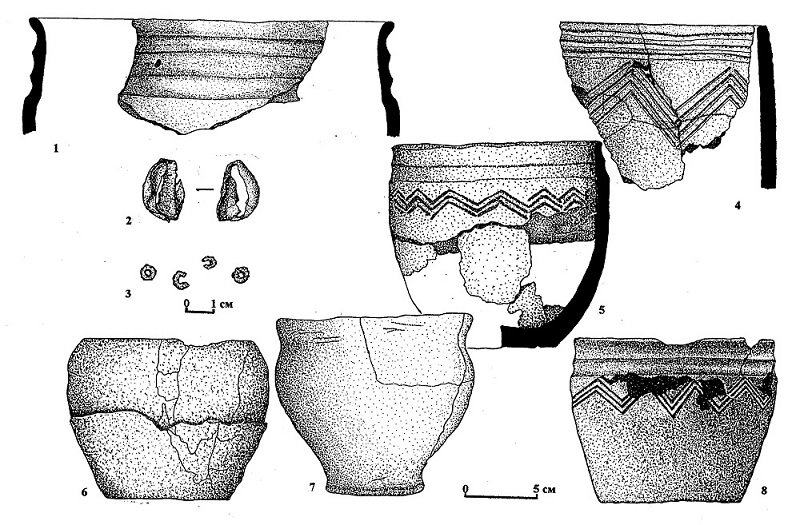
In different years, excavations were carried out on all these monuments, and although the degree of their study varies, the data obtained, including the determination of the absolute age, made it possible to perform cultural and chronological attribution.
All burial grounds of the Bronze Age are included in the circle of monuments of the Andronovo cultural and historical community. Typologically, the monuments of Tanbaly belong to the Central Kazakhstan (Atasu) and Semirechensk variants of the Andronovo community, reflecting the migration-diffuse nature of the formation of the population of southeastern Kazakhstan in the late Bronze Age.
The most ancient monuments of the complex are the burial grounds of Tanbaly I, V, VI, which functioned synchronously in the second half of the XIV-XIII centuries BC. The peculiarities of these monuments include the burial of the deceased according to the rite of the corpse-laying crouched on their sides in large stone boxes inside round or square fences of vertically installed stone slabs. The funeral inventory is represented by elegant ornamented stucco dishes and bronze ornaments.
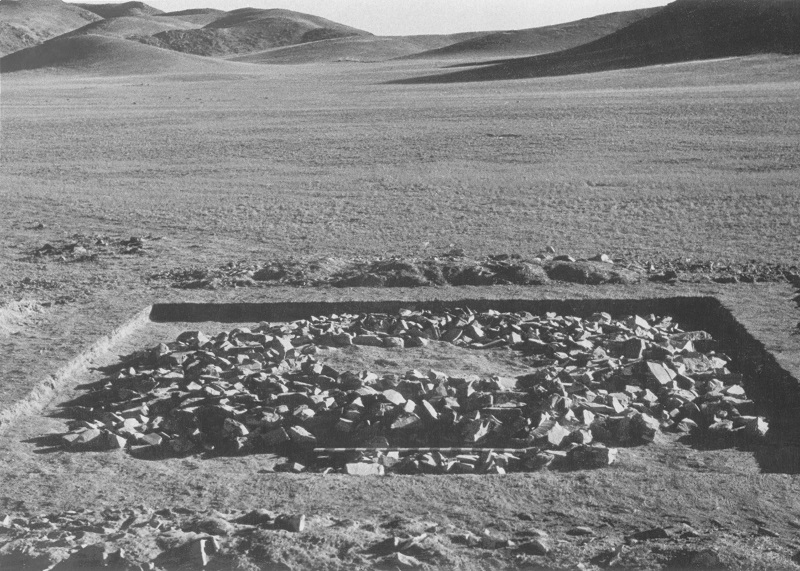
At the turn of the XIII/XII centuries BC, the burial grounds of Tanbaly II, IV and Karakuduk II, belonging to the monuments of the Semirechensk type of the Late Bronze Age, were formed. They are characterized by a combination of burial according to the rite of corpse laying and cremation in stone boxes and cysts, rough unornamented stucco ceramics and a specific set of bronze jewelry and products. Petroglyphs – anthropomorphic figures and images of animals – made in the style of the oldest series of rock paintings of Tanbaly were found on several stones in three cists of the burial grounds of Tanbaly II and Karakuduk II.
The most recent burials of the Bronze Age were found on the periphery of the burial ground of Tanbaly VI and Tanbaly VII and date back to the XI-X centuries BC.
Burial mounds were found everywhere in the tract and are represented by several types, differing in the features of the mound and burial structures. The largest burial grounds, consisting of two to three dozen structures, are located on the foothill plain.

Petroglyphs of Sunkarsai (Group VII) (N 43º4831,95; E 075º3148,44). Sunkarsai Gorge is located 700 m northwest of the central Tanbaly Gorge. It is a shallow valley among the typical low mountains of Chu-Ili with a small stream that had a seasonal flow that provided the inhabitants of the gorge, currently existing only in spring. The largest accumulation of petroglyphs is located on the hill at the exit of the gorge. The cluster has 150 planes with more than 500 petroglyphs, which date back to the Late Bronze Age, the Saka era, as well as the Middle Ages. Often, petroglyphs were updated at a later time, sometimes new images were added. The full documentation of the rock art of the main hill was done by L. Hermann and B.Zheleznyakov in 2011, in the same year a tourist route was opened along its petroglyphs.
Most of the rock carvings represent animals, in particular goats and camels, the image of which partly dates back to the Bronze Age, but most of them belong to the RSV. Especially characteristic of this era is the depiction of a deer with horns in the form of a "tree of life". Images of the Early and Middle Ages clearly predominate in Sunkarsai. The Turkic images also quite clearly emphasize the characteristic features of their period: several scenes show horsemen with banners, hunting scenes with bows or a bird of prey. There are known signs-tamgas, depicted both separately and among a large multi-temporal scene - a palimpsest. The tamgas obviously marked a settlement that existed at a later time on the layers of settlements of an earlier time. Not far from the gorge, on the plain, there is a mound "with a mustache".
Mounds with "moustaches" (stone laying); (N 43º4843,6; E 075º3201,8). The monument was opened and partially explored on October 1-5, 1957 by the Semirechensk detachment of the South Kazakhstan Archaeological Expedition of the Academy of Sciences of the Kazakh SSR under the direction of A. G. Maksimova. Dating: Early Iron Age – Early Middle Ages. The structure consists of a central mound (stone embankment d - 6 m, h - 0.5 m) and two arched stone mounds ("whiskers") extending from it to the northeast and southeast; at the ends of both mounds there are small mounds (d - 2 m, h - 0.2 m). During the excavation of the burial mounds, no burials were found; excavations of arc-shaped calculations-"whiskers" were not carried out. The purpose of the structure has not been established. The monument was reconstructed in 2005.
Petroglyphs of Shoshkaly (N 43º4922,64E 075º2929,71)
The picturesque tract is located in the northwestern and northern part of the reserve-museum "Tanbaly", in the most mountainous and rugged terrain. But, despite the abundance of rocky outcrops, there are few patinated surfaces. One of the most significant clusters of petroglyphs is located in the meander of the Oisu riverbed flowing through the Shoshkala Gorge. The landscape has preserved its pristine state.
Petroglyphs were studied and published by S.A. Potapov, it was he who noted the peculiarity of the tradition of knocking out a small part of the bulls of this location, similar to Kulzhabasy, obviously belonging to an older period than the main part of the images in Tanbaly. The main part of the petroglyphs is carved on the rocks with a south-western exposure on the right bank of the drying stream. There are more than a hundred planes knocked out in different epochs, starting from the Bronze Age (very archaic bulls, chariot), many of which were renovated or supplemented in the Middle Ages. A significant part of the images are images made in the "animal style" in the Saka time. There are also images of the third quarter of the 20th century, which are based on images of the "leader of the world proletariat" and the theme of love. In 2011, practical classes of an international seminar were held here under the leadership of A.E. Rogozhinsky, as a result, a map of the archaeological sites of this tract was obtained.
The petroglyphs of Shoshkala are equidistant from Tanbaly and Karakyr (located 4 km from both monuments, as if halfway between them), this creates significant prospects for the further development of tourist routes for visitors and for understanding the cultural landscape of Tanbaly-Shoshkala-Karakyr by specialists. It is here that it is planned to lay a trail through the natural attractions of Tanbaly.
Due to the relatively low position above sea level and the considerable distance from high mountain ranges, the Chu-Ili Mountains receive a relatively small amount of precipitation. At high and sultry temperatures in the summer months, the amount of precipitation per year does not exceed 250 mm. Only the central, more elevated part receives, probably, a little more, up to 300 mm. Because of this, irrigation of the entire area is extremely scarce. Almost all the rivers that have their sources in the Chu-Ili Mountains are filled with water only periodically, during the melting of snow.
For the territory of the Chu-Ili Mountains, about 900 species of higher plants are given, of which about 80 are southern species, which have the northern border of the range here.
It is very beautiful here in spring, when all the slopes are covered with spring flowers. Tuber geranium, spring peas, rinder, stork, Persian rose, Tatar ixilirion, gentians and onions bloom in steppe areas. Spiraea and karagana are beautiful from the bushes. In some areas, the tulip buze blooms like a solid carpet. Later it is replaced by orange rheomeria, poppies and hobbles. On the rocky slopes, among the colorful lichens, the spots of yellow goose bows, valerian, yellow anemones, ferules, white carnations and kermek look picturesque. The most interesting plants are found in these places, such as korolkovia Severtseva, Karelin's rhinopetulum, juno blue, Albert's tulips of red and yellow flowers and, finally, the unique Regel tulip - the oldest of tulips. Its corolla is pure white with a yellow base inside, and the leaves are short, wide, corrugated. In the relief depressions, flowering bushes of various curly, chingil and tamarisk are beautiful. Along the rivers, in many places, reeds rise in a solid ribbon, and in some places there are centuries-old willows. By the end of June, this whole symphony of bright colors is burning out. Hot weather usually lasts until mid-September. At this time, you can find one unique plant on the rocks – a powerful one - the endemic of these places. In addition to it, you can also name such a narrowly endemic plant as Nedzvedskiya Semirechenskaya (a representative of past geological epochs).
Several thousand years ago, the climate here was more humid and mild, with full-flowing rivers, with rich groves along the banks of rivers and rich pastures. In modern times, this area has an original flora that has no analogues in the world. It is enough to name such endemic plants as Regel's tulip, Nedzvedskiya (a plant of past geological epochs) and nagolovatka. The fauna of these mountains is still poorly studied. Nevertheless, it is possible to name the endemic beetle Callistenes (Callistenes) and recently found day butterflies - Rhymnaria Vavilov (Rhymnaria vavilovi) and Rhymnaria chuiliense (Rhymnaria chuiliense).


 3D Tour of Tanbaly
3D Tour of Tanbaly